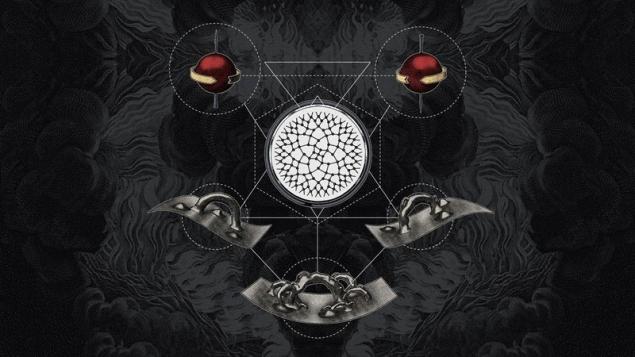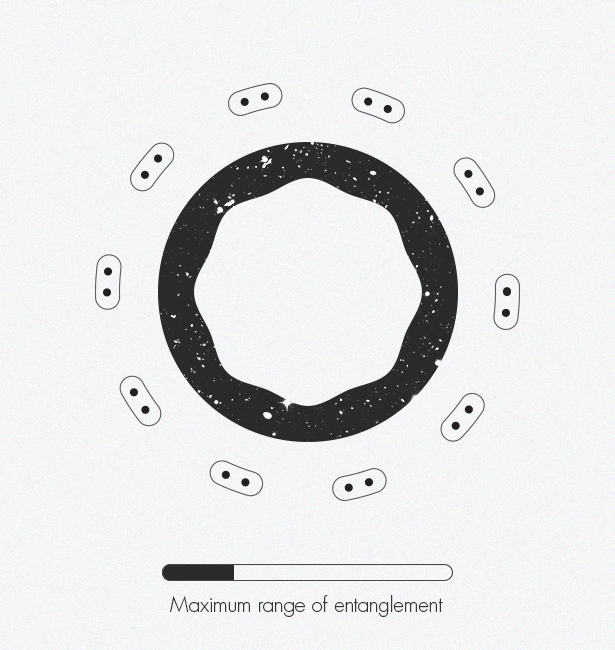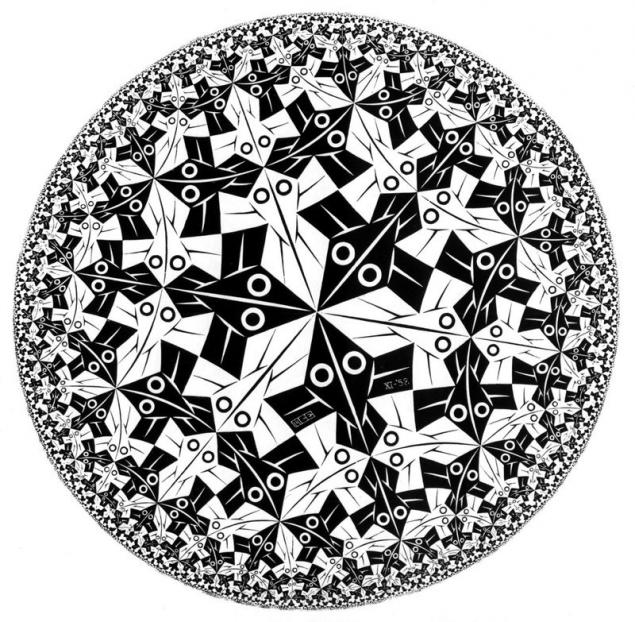What is space-time?
 Bashny.Net
Bashny.Net

Brian record layer was a graduate student, studied the physics of substances at mit, when he suddenly decided to take a few lessons in string theory, to support his education as he recalls, "because why not?" although never really interested in this area. As you go deeper into the details of the record layer began to notice an unexpected affinity approach of string theory to the physics of black holes and quantum gravity with his own work in which he used the so-called tensor network to predict the properties of exotic materials.
"I realized something profound," he says.
Tensors arise throughout physics is simple mathematical objects, which can represent multiple numbers at the same time. For example, the velocity vector is a simple tensor: it captures the speed and direction of movement. More complicated tensors associated to the network, can be used to simplify calculations of complex systems consisting of many different interacting parts, including the complex interaction of vast numbers of subatomic particles that make up matter.
The record layer is one of a growing number of physicists who see the value in adaptation of tensor networks to cosmology. Among other advantages, it may help resolve the ongoing debate about the nature of space-time. According to John, Priscilla, Professor of theoretical physics at the California Institute of technology in Pasadena, many physicists suspected a deep connection between quantum entanglement — "spooky action at a distance" so disliked albert Einstein and the geometry of space-time on the smallest scale, which physicist John Wheeler first described as a bubbling foam, six decades ago.
"If you study geometry at scales close to the Planck length, is the shortest of all possible — it will be less and less like space-time, says Preskill. — In fact, it would not be geometry. It's something else, emerging from something more fundamental".
Physicists continue to struggle with this perplexing problem associated with the fundamental picture, but very suspect that it is related to quantum information. "When we say that information is coded, we mean that we can split the system into parts, and there will be some correlation between these parts so that you can learn something about one part observing the other," says Preskill. This is the essence of entanglement.
We used to talk about the "fabric" of space-time, metaphor that invokes the image of satkania threads in a smooth and continuous single unit. This thread is fundamentally quantum. "Confusion is the fabric of space-time, says the record layer, now a scholar at Stanford University. Is the thread that ties everything together, making the collective properties different from the individual. But to see the interesting collective behavior in fact, you need to understand how entanglement is distributed".
Tensor networks provide a mathematical tool that allows to do it. From this point of view, space-time arises as a network of interlinked nodes complex network, with separate pieces of quantum information that are linked together like LEGO. Entanglement is the glue that holds the network together. If we want to understand space-time, we need to think geometrically about confusion, because in this way the information encoded in an infinite number of interacting nodes in the system.
Many bodies, one сеть

To simulate the complex quantum system — is no easy feat; even the classical system with more than two interacting parts seem to have a problem. When Isaac Newton published his "Start" in 1687, one of the many topics he touched, became known as the "problem of three bodies". This is a relatively simple question: calculate the motion of two objects like the earth and the Sun, taking into account the effects of their mutual gravitational attraction. However, if you add a third body like the moon, the task becomes enormously difficult issue with respect to the direct and concrete solution is chaotic, where long-term forecasting requires powerful computers for modelling the approximate evolution of the system. In short, the more objects in the system, the harder it is to compute, and that difficulty increases linearly, at least in classical physics.
Now, imagine a quantum system with many billions of atoms, all of which interact with each other according to a complex quantum equations. On such a scale, the complexity increases exponentially with the number of particles in the system, so that the approach is brute computing power is not going to work.
Imagine a gold nugget. It consists of many billions of atoms that interact with each other. From these interactions follow different metal properties, color, strength or conductivity. "Atoms are tiny quantum-mechanical stuff, you put the atoms together and happen klassnenkiy new things," says the record layer. But to the extent the rules of quantum mechanics. Physicists need to accurately calculate the wave function of this nugget, which describes the state of the system. This wave function is a many-headed dragon of exponential complexity.
Even if your nugget is just 100 atoms, each with quantum "spin", which can be either upper or lower, the total number of possible States is 2^100, or a million trillion trillion. With each added atom, the problem becomes immeasurably worse. (And will get worse if you choose carefully to describe something in addition to the spin of the atoms, according to any realistic model). "If you take the entire visible Universe and fill it with our best material for storage, to make the best possible hard drives you can save the state just 300 spins, says the record layer. — This information is present, but it's not about physicists. No one has ever measured all these numbers".
Tensor networks allow physicists to compress all the information contained in the wave function, and to apply only to those properties that physicists can measure experimentally: as a material of the light curves, for example, or how it absorbs the sound, or how well it conducts electricity. A tensor is a kind of "black box" that takes one set of numbers and issues completely different. Thus, it is possible to connect a simple wave function — the set of noninteracting electrons, each in their lowest energy state and to pass the tensors in the system again and again until the process will produce a wave function of large and complex systems, a billion interacting atoms in a nugget of gold. The result is a fairly simple diagram depicting this complex ingot of gold, an innovation akin to the Feynman diagrams that simplify the submission process of interaction of particles in the mid-20th century. From the tensor network geometry as space-time.
The key to achieving this simplification is the principle called "locality". Any individual electron interacts only with its nearest neighbors-electrons. The entanglement of multiple electrons with its neighbours produces a series of "nodes" in the network. These nodes are represented by tensors, and confusion connects them together. All of these connected nodes make up the network. Complex the calculation becomes easier to visualize. Sometimes he even comes down to the simple problem of counting.
There are many different types of tensor networks, but among the most useful there is one, known by the acronym MERA (multiscale renormalization ansatz entanglement). Here's how it works in principle: imagine a one-dimensional line of electrons. Replace eight separate electrons — A, B, C, D, E, F, G, H — basic unit of quantum information (qubits) and tangle them with the immediate neighbors to establish a connection. A entangled with B, C becomes entangled with D, E confused with F, G confused with H. This raises the network to a higher level. Now mix AB CD, EF GH with another level. Finally, associated with ABCD EFGH, forming the highest layer. "In a sense, we can say that the entanglement is used to build the polynomial wave function," wrote the Roman Orus, a physicist from the University Johannes Gutenberg in Germany.
Why some physicists are so excited by the potential of tensor networks — especially MERA — in the light of quantum gravity? Because these networks show how one geometric structure can emerge from complex interactions of many objects. And a record layer (along with others) hopes to take advantage of this resulting geometry and show how it can explain the emergence of a smooth continuous spacetime from discrete bits of quantum information.
The boundaries of space-времени

Physics kondensirovannykh environments accidentally found emerging an extra dimension when he developed tensor networks: this technique gives two-dimensional system of the same dimension. Meanwhile, the theorists of gravity began to subtract the dimension from three to two — with the development of the so-called holographic principle. Is it possible to combine these two concepts to form a deep understanding of space-time?
In the 1970's, physicist Jacob, Bekenstein showed that the information content of a black hole is encoded in its two-dimensional area ("border"), but not in three-dimensional ("volume"). Twenty years later Leonard Susskind and Gerard t Hooft expanded on this idea to the whole universe, likening her hologram: our three-dimensional universe in all its glory stems from the two-dimensional "source code". In 1997 Juan Maldacena found specific examples of holography in action, demonstrating that the toy model that describes a flat space without gravity, is equivalent to the description of the saddle-shaped space with gravity. This relationship of physics called duality.
Mark van Raamsdonk, a string theorist from the University of British Columbia in Vancouver, compares this idea with a holographic two-dimensional computer chip that contains the code to create a three-dimensional virtual world of video games. We live in this three-dimensional game space. In a sense, our space is illusory, ephemeral painting hanging in thin air. But as stressed by van Raamsdonk, "there is a real physical thing in your computer that stores all this information."
This idea has gained wide acceptance among physicists-theorists, but they are still struggling with the problem: how exactly lower dimension can store information about the geometry of space-time. The stumbling block is that our metaphorical memory chip needs to be something like a quantum computer, where the traditional zero's and one's that are used to encode information, are replaced by qubits, can be zeros, ones and everything in between, simultaneously. These qubits were to unite with the help of entanglement — in which the state of one qubit depends on the state of his neighbor before he could be encoded realistic three-dimensional world.
Involvement seems fundamental to the existence of space-time. This is the conclusion in 2006 came a pair of scientists: Shinsei Ryu (University of Illinois), and Tadashi Takayanagi (Kyoto University), received the prize of the 2015 New Horizons in physics for this work. "The idea was that the way in which was encoded the geometry of space-time, has a lot to do with how different parts of our memory chips entangled with one another," explains van Raamsdonk.
Inspired by their work, and also work Maldacena, in 2010 van Raamsdonk proposed a thought experiment that demonstrates the critical role of involvement in the formation of space-time, pondering what might happen if you cut the memory chip into two, and then remove entanglement between qubits in opposite halves. He found that the space-time begins to tear itself apart, like stretching chewing gum in different parts forms a ragged hole in the center. Continuing to share this memory chip into smaller and smaller pieces, you can break space-time, until there is only a tiny individual fragments that are not associated with each other.
"If you remove your confusion, your space-time fall apart, says van Raamsdonk. — Similarly, if you want to build space-time, you need to start with the entanglement of the qubits together in a certain way".
Combine these ideas with the work of the record layer's connection confusing structure of space-time and the holographic principle, tensor networks, and one important piece of the puzzle will fall into place. Curved space-time rather flows naturally from entanglement in tensor networks via holography. "Space-time is a geometrical representation of quantum information," says van Raamsdonk.

And what exactly does geometry? In the case of saddle-shaped space-time Maldacena, she looks like one of the shapes cycle "Limit — circle" Maurits Cornelis Escher the late 50's-early 60's. Escher long been interested in order and symmetry, including these mathematical ideas in his art.
His woodcut "Limit — circle" is an illustration of hyperbolic geometry: negatively curved space represented in two dimensions in the form of a distorted disc, like a flat globe of the Earth onto a two-dimensional map distorts the continents. The record layer claims that diagrammy tensor networks bear a striking resemblance to a series of "Limit — circle".
Today tensor analysis was restricted to models of space-time like muldestausee that do not describe the universe in which we live — the universe nestedloops form, which means that the expansion is accelerating. Physics can only make transfers between the two models in some cases. Ideally, they would like to get a universal dictionary. And they would like to do accurate translations, not close.
"We are in a funny situation with these dualities, as all agree, say, Yes, it's important, but nobody knows how to translate them, says Preskill. — Possible approach with tensor network will allow you to go further".
Over the past year, a record layer and van Raamsdonk did a lot of joint work to bring your range of vision beyond the static picture of space-time and investigate its dynamics: how space-time evolves over time and how its curvature responds to these changes. So far they have managed to bring the Einstein equations, in particular the principle of equivalence — a proof that the dynamics of space-time and its geometry, derive from the entangled qubits. This is a promising start.
"Question: what is space-time? It sounds like a completely philosophical question, says van Raamsdonk. — However, it is quite specific, and the fact that space-time can be calculated, quite surprising." published
P. S. And remember, only by changing their consumption — together we change the world! ©
Source: hi-news.ru
Tags
See also
What would happen if the Solar system will be a black hole?
Facts about black holes
10 interesting facts that you should know about black holes
10 surprises that we were treated to black holes
Scientists have derived a mathematical proof that black holes cannot exist in reality
Black holes: the Paradox of information loss
What caused the rapid growth of black holes
Scientists have found a giant black hole in an ordinary galaxy
Why physicists can't stand the information paradox of black holes?
Black holes continue to surprise us

















